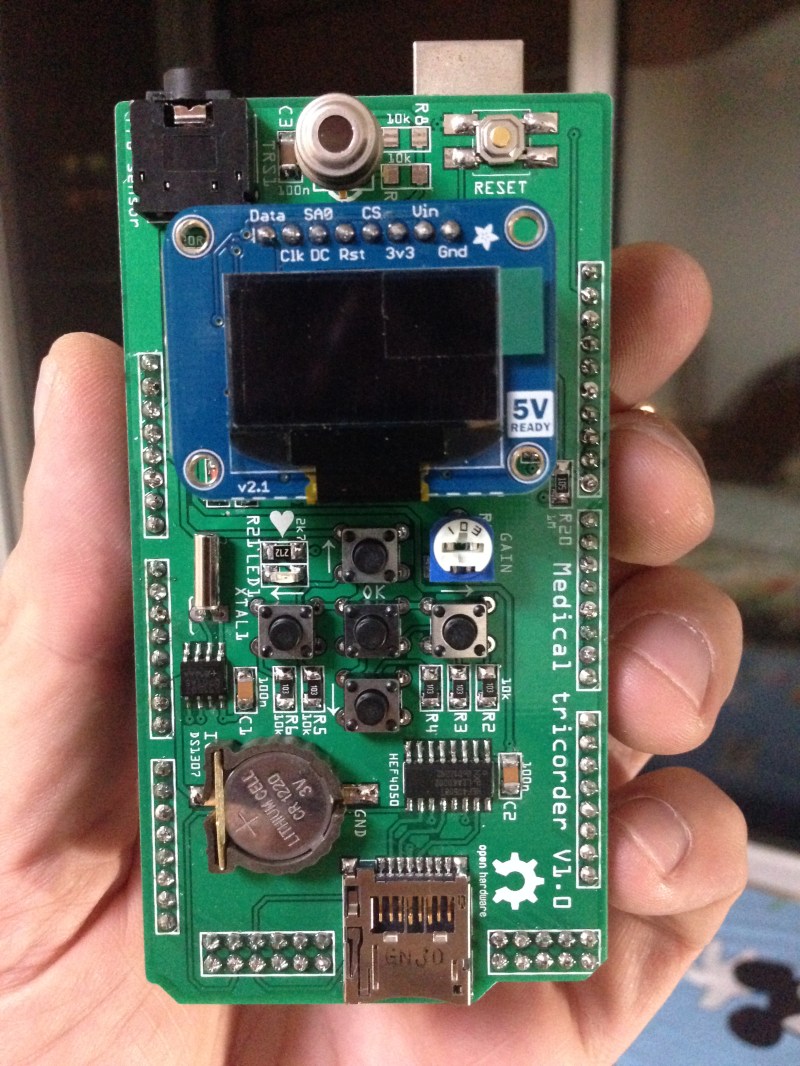A handheld tricorder is as good a reason as any to start a project. The science-fiction-derived form factor provides an opportunity to work on a lot of different areas of hardware development like portable power, charging, communications between sensor and microcontroller. And of course you need a user interface so that the values being returned will have some meaning for the user.
[Marcus B] has done a great job with all of this in his first version of a medical tricorder. The current design hosts two sensors, one measures skin temperature using infrared, the other is a pulse sensor.
For us it’s not the number of sensors that makes something a “tricorder” but the ability of the device to use those sensors to make a diagnosis (or to give the user enough hints to come to their own conclusion). [Marcus] shares similar views and with that in mind has designed in a real-time clock and an SD card slot. These can be used to log sensor data over time which may then be able to suggest ailments based on a known set of common diagnosis parameters.
Looking at the image above you may be wondering which chip is the microcontroller. This build is actually a shield for an Arduino hiding underneath.
There’s a demonstration video after the break. And if you find this impressive you won’t want to miss the Open Source Science Tricorder which is one of the finalists for the 2014 Hackaday Prize.
















Nice work. Good piece of equipment. Potential there, yes you have!
I was in on the earliest for emergency cardiac care. The code is really a team of docs debating till consensus arrived, then some programmer converting their “discussion and conclusions” into code. That was enough of an experience that I am quite happy having sidestepped AED development today, but suggest you should step forward and become one of the giants whose shoulders the future will stand apon as they rise to greater heights. .
You Sir, are a candidate to which I suggest BMET certification.
Video showing more progress:
https://www.youtube.com/watch?v=gICMXpYILWc
“it’s not the number of sensors that makes something a “tricorder” but the ability of the device to use those sensors to make a diagnosis”: That’s not so hard. The diagnosis is always “He’s dead, Jim.”
I wonder what the ‘tri’ refers to, maybe in the original TV show it was suppose to be ‘try’-corder. Or does it come from ‘triage’ which comes from the french trier for ‘separate out’.
I always assumed it was the prefix meaning “three”.
Actually there are 3 sensors. The IR thermometer acts also as a respiratory rate sensor. It cools down the sensor when breathing out…Patent pending issue…
http://en.wikipedia.org/wiki/Tricorder
The word “tricorder” is an abbreviation of the device’s full name, the “TRI-function reCORDER”, referring to the device’s primary functions; Sensing, Computing and Recording.
Didn’t think to check wikipedia on this one, I thought the info would be on some obscure fansite wiki.
Thanks for the link and info.
Star Trek nerd here. It stands for the three different functions. Gather data, store data, and perform computations on the said data.
The CDC version when it measures 103F will say “Congrats, you are absolutely 100% sure free of ebola”
And at 536F burn baby burn?
My 2c here. You’ve done a great job.
I think I understand the choice of sensors but wonder if the sensor package should be aimed a bit higher? I’m a doctor, not a doorstop!
Ultimately, it takes about 15 minutes to teach someone in clinic how to take a heart rate and count breaths. As for temperature, infrared sensing outside the outer ear is usually subject to enough error to make it not too dissimilar to the back of the hand.
Three tests I wish I had in the palm of every paramedic or post-scarcity horizon exploring medical officer?
(None are easy to do and the first is possibly the one with the most hidden tricks)
1) Pulse Oximetry +/- CO2, Hb, methaemaglobin
It’s easy to tell that their heart is beating and they’re breathing or not. But outside “blue means roughly 30-60g/dL deoxyhaemaglobin” working out how effective im those beaths n beats are without gadgetry is tricky
2) ECG without the fuss
It means careful design and analog processing, but even a single channel ECG can help work out what treatment is likely to be most effective should that heartbeat be ineffective
3) Fingerprick blood analysis
It would be nigh impossible without reagents, but the shotgun wish list would be pH, Haematocrit, Glucose, Cardiac Troponin, Prothrombin/INR and lactate. Evernote spectroscopy needs to be able to cause an emission or absorbtion in a contained sample.
Good luck and keep hacking, Bones!
I bet there would be a lot of cyclists that would like a device that could instantly measure hematocrit :)
Many would use it for that, yet ironically CO2 or O2 and heart rate would probably guide better training (in order to calibrate anaerobic threshold training and assess VOmax, the maximal O2 tissue delivery / consumption)
To avoid to much complexity and risk (you should be careful when starting to draw blood) for now they could maybe add a simple skin conductivity sensor, it’s cheap and easy but still gives information.
And a color sensor to check fingernails, which seem to indicate quite a few bits of info about health by the amount of redness, and use it to check skin maybe.
Finally it’s listed here. You did a great job Markus. Seeing an Open Source device like that gives me hope that mankind will survive :-)